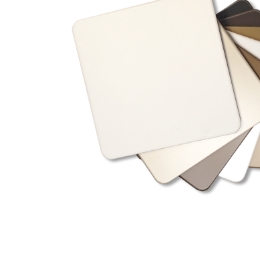How Do You Know If A Building’s Wall Assembly Is Fire Safe?
Fire protection engineer breaks down wall system fire safety and the NFPA 285
by Michael Bowie and Art Parker
Be code-compliant. That’s the simplified answer to a very complex problem.
How do you select the right products for your project’s cladding? The external wall assembly has multiple components. The substrate, air water barrier, attachment system, insulation, and cladding material each play into the calculation of a wall system’s performance. Even something as simple as the depth of the air cavity can play a critical role. Building construction professionals turn to the experts to help them navigate the seemingly infinite configurations to stay fire safe.
In the world of code compliance, the name Art Parker is well known. Senior fire protection engineer and licensed PE, Parker’s career spans three decades and his work from the world-renowned firm of Jensen Hughes has driven our discussion of fire safety standards. He is active in the committees that help write the code and has conducted countless tests, analyses, and investigations in fire safety. Parker knows what it takes to be code-compliant.

What is the role of a fire protection engineer?
Parker describes the model building code as a system to prevent people from getting hurt. It details the minimum requirements for a building assembly. Often, defining that standard with testing requirements. “The role of a fire protection engineer is to evaluate and potentially test to confirm that we’ve achieved compliance with the building code requirements. That we meet the life safety requirements in the built environment. To keep people safe.”
Part of an independent consulting firm, fire engineers like Parker review each specific component in a proposed wall assembly. They work with clients, commercial laboratories, manufacturers, and the design team. “Our experience and expertise in the testing and the materials in the assembly performance allows us to help the design team to make changes that will result in the assembly complying with the requirements,” explains Parker.
Letters of equivalency and engineering judgments.
While the possible combinations of products and construction configurations are nearly infinite, limited resources create a significant constraint for cladding professionals. “It’s costly and time consuming to conduct a test,” explains Parker. “It’s simply not practical to test every exterior wall permutation that’s out there. So, we utilize engineering judgments.”
Parker describes the section of the model building code that enables an evaluation of alternative methods and materials. Fire protection engineers review a tested assembly and compare that to a proposed project assembly, systematically evaluating the differences in construction to determine their impact and the ability to meet the code requirements. “It’s a tool that allows me to bridge the gap between a limited number of tested and qualified systems and a near limitless number of proposed wall assembly constructions.”

NFPA 285 is the key to dependable wall performance.
NFPA 285 is the Standard Fire Test Method for Evaluation of Fire Propagation Characteristics of Exterior Wall Assemblies Containing Combustible Components. It’s a full-scale wall assembly test conducted in a controlled environment. This test simulates an event where a flame, originating from either inside the building or an external source adjacent to the building, starts to spread up the wall assembly.
“We have active fire suppression systems like sprinklers and detectors. We use passive protection systems like installation materials on structural steel. But we want to test a wall system where there are no middle mitigation factors,” states Parker. He describes the NFPA 285 test as the worst-case scenario. “By ensuring I test to a very worst case, the expected performance in the big picture is going to be much better.”
Since its inception in 1998, there have been notable changes made to this standard over the years. In the 5th edition, released in 2023, the NFPA revised the scope to clarify this is an assembly test method. It provided new limits on wall projections and details on sealing the tops and sides of walls. And most notably, it included the addition of Annex B, “Guide for Extensions of Results from Assemblies that Meet NFPA 285 Test Requirements.”
Understanding the importance of NFPA 285 Annex B.
“We’ve been conducting engineering evaluations for many, many years. Over that time, we’ve developed sort of guidelines,” says Parker. He’s excited to see the addition of Annex B because it created an industry consensus and codified many of the best practices for conducting the engineering analysis for exterior walls.
“The NFPA test committee documented many of those engineering evaluations, sort of rules, if you will. So, the benefit of that is, it's now down on paper. Everybody can look at that and understand what the process should be to ensure that we are evaluating a wall assembly correctly.” Most importantly, Parker adds, it can be used by the design team and building officials to ensure that what they receive from a fire protection engineer demonstrates compliance. “It’s another double-check to ensure we’ve achieved compliance. We’ve built in continuity and consistency amongst the fire protection community to ensure that we're all evaluating in the same manner.”
Finding partners you can trust.
Parker stresses that this process, which has been around for decades, has continued to evolve. “I think we've tried to improve that process with the entire team, from the manufacturers all the way through to the installers and all the approvals and evaluations in between to ensure that we're reducing the risk.” He feels that a unique aspect of the US code is that we have a multi-layered system of testing, evaluation, approval and inspection. “Especially with exterior wall assemblies, we've done a really good job of ensuring that whatever we specify, and actually build, is what we all thought should be there.”
While the architectural community continues to exercise its creativity, there will continue to be new, untested systems that will need to be evaluated. Choosing an independent licensed fire protection engineer and the right building material manufacturer can help give peace of mind. “We’re working closely with the material manufacturers, like ALPOLIC. Everybody is doing their due diligence of evaluation and analysis to ensure that we have a compliant system at the end of the day,” explains Parker.
Safe and beautiful metal composite materials (MCM) are versatile, sustainable, and redefining skylines the world over. “MCM panels that have been incorporated in a wall assembly tested in accordance with NFPA 285 are safe to be used on buildings,” attests Parker. When it comes to specifications, for him it’s as simple as requiring an MCM cladded wall assembly that has met the requirements of NFPA 285. “That’s key, and then we’ll meet those life safety code requirements.”
Art Parker is a senior fire protection engineer at Jensen Hughes. He has been responsible for conducting numerous testing, analyses, and code compliance investigations involving exterior wall assemblies incorporating combustible exterior wall coverings, continuous insulation materials and air/vapor barrier products. Art is active with ASTM Committee E05 on Fire Standards and the NFPA Fire Test Committee, which developed and maintains the NFPA 285 test standard.
Michael Bowie is the technical services manager in the ALPOLIC Division of Mitsubishi Chemical America. After a decade of hands-on experience with the production and quality assurance of MCM, he stands ready to answer your technical questions. Learn more about how MCM can fit into your next project by scheduling an AIA-accredited continuation education course today.






